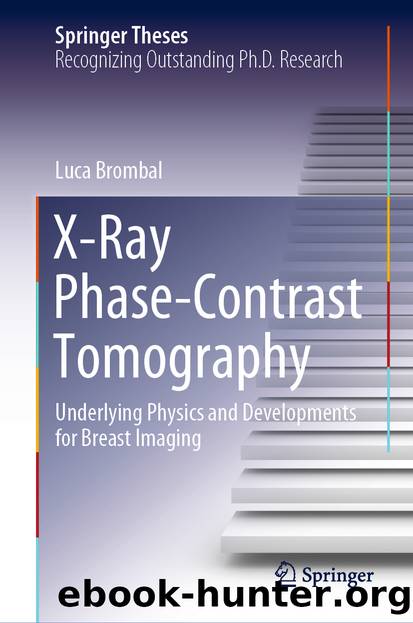X-Ray Phase-Contrast Tomography by Luca Brombal

Author:Luca Brombal
Language: eng
Format: epub
ISBN: 9783030604332
Publisher: Springer International Publishing
PhR
1.52 m
2.72 m
6.44 m
SNR
No
1.63 (0.02)
1.63 (0.03)
1.62 (0.01)
Yes
8.45 (0.13)
13.3 (0.3)
33.8 (0.7)
Contrast (%)
No
48.9 (0.5)
44.1 (0.5)
50.0 (0.4)
Yes
48.6 (0.3)
44.2 (0.1)
49.1 (< 0.1)
FWHM (px)
Yes
2.1 (0.5)
2.3 (0.3)
2.4 (0.2)
The quantitative results of the image analysis are reported in Table 5.2. As predicted by the theory (see Table 5.1) the SNR, calculated according to Eq. 5.11, does not vary significantly with the propagation distance if no PhR is applied, while its increase due to PhR is greater than a factor of 20 when considering 6.44 m of propagation distance. In addition, it must be noted that only little contrast variations (below 6%) are observed when changing the distance while, at a given position, no relevant contrast alterations are associated to the PhR algorithm whose action is limited to image noise. The latter observation is of great importance in sight of the clinical application of this technique, since the image appearance will look âfamiliarâ to the clinicianâs eye, who will not require a specific training to read the images, as it may occur for other phase-contrast techniques. Furthermore, considering phase-retrieved images, the FWHM measured in pixel units does not vary significantly with the propagation distances and, in all cases, it was found to be slightly higher than 2 pixels (120 m on the detector plane). This implies that, taking into account the magnification, the actual spatial resolution slightly improves at longer distances (FWHM 100 m) at the expense of a smaller field of view.
With the aim of a better data visualization, the measured SNR gain, contrast and spatial resolution concerning the phase-retrieved images (points) and the theoretical predictions (lines) are plotted as a function of the propagation distance in Fig. 5.4. From the top panel it can be seen that the measured SNR gain is in remarkable agreement with the model results obtained via numerical integration considering realistic detector and reconstruction parameters (solid line). Interestingly, if the analytical formula given in Eq. (5.10) is followed instead of numerical integration, the predicted SNR gain factor (dashed line) is about 2-fold higher than the measured one. This can be easily explained taking into account the number of simplifications made in deriving that expression, the fundamental one being the rather unrealistic assumption of a detector featuring a constant MTF up to the Nyquist frequency: for this reason the values predicted according to the analytical formula constitute, in practice, an upper limit in terms of SNR gain when compared with experimental data. At the same time, it is worth mentioning that the factor of 2 difference between the two different approaches is almost constant at all the propagation distances, hence, even if Eq. (5.10) does not provide an accurate estimate of SNR gain factors in absolute terms, it still provides the correct trend with respect to the propagation distance. In addition, when comparing phase-retrieved images, a 4-fold increase in SNR is observed at 6.44 m with respect to the shortest propagation distance (1.52 m): remarkably, at a fixed propagation distance, such SNR increase would correspond to a 16-fold higher radiation dose.
Fig. 5.4Comparison between
Download
This site does not store any files on its server. We only index and link to content provided by other sites. Please contact the content providers to delete copyright contents if any and email us, we'll remove relevant links or contents immediately.
The Complete Stick Figure Physics Tutorials by Allen Sarah(7264)
Secrets of Antigravity Propulsion: Tesla, UFOs, and Classified Aerospace Technology by Ph.D. Paul A. Laviolette(5237)
Thing Explainer by Randall Munroe(3849)
The River of Consciousness by Oliver Sacks(3498)
The Order of Time by Carlo Rovelli(3097)
How To by Randall Munroe(2969)
A Brief History of Time by Stephen Hawking(2911)
I Live in the Future & Here's How It Works by Nick Bilton(2900)
The Great Unknown by Marcus du Sautoy(2612)
What If?: Serious Scientific Answers to Absurd Hypothetical Questions by Randall Munroe(2589)
Midnight in Chernobyl by Adam Higginbotham(2432)
Blockchain: Ultimate Step By Step Guide To Understanding Blockchain Technology, Bitcoin Creation, and the future of Money (Novice to Expert) by Keizer Söze(2409)
Networks: An Introduction by Newman Mark(2304)
The Meaning of it All by Richard Feynman(2268)
Easy Electronics by Charles Platt(2252)
The Tao of Physics by Fritjof Capra(2204)
Midnight in Chernobyl: The Untold Story of the World's Greatest Nuclear Disaster by Adam Higginbotham(2126)
When by Daniel H Pink(2057)
Introducing Relativity by Bruce Bassett(2048)
